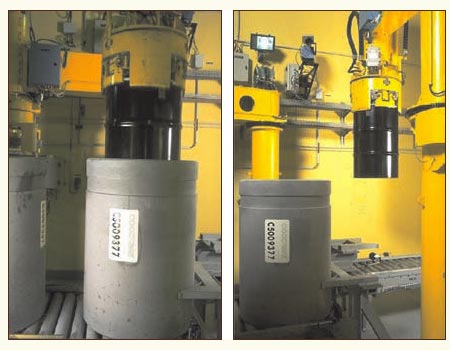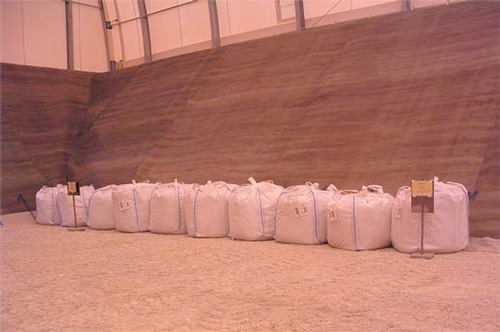Low and very low level waste
Basic conditioning for low-level and very low-level waste

Metal drum containing cement-bound waste
This metal drum contains cement-bound operating waste from AREVA’s Pierrelatte facility. These waste categories are generated during workshop operation (gloves, vinyl and fabric coveralls, etc.) as well as maintenance and dismantling operations (metal equipment and tools). They are produced by industrial activities at the front end of the fuel cycle. In this case they are immobilised in a cement-based material and conditioned in 200 l drums.
© ANDRA (Catalogue sheet ref. F3-1-03)
Waste in which the radioactivity is low or very low, or decays to harmless levels within a few decades, may be conditioned in adapted standard packaging and is subject to much less strict requirements than high- and intermediate-level waste. This is the case of the two most voluminous waste categories requiring disposal, namely low- and intermediate-level short-lived waste (LILW-SL) and very low-level waste (VLLW). The proportions of radioactive atoms and the corresponding radiation fluxes are tens of thousands of times lower in such waste.
Containers and conditioning matrixes are sufficient. Containers may be made of concrete, non-alloy steel (ordinary steel) or alloy steel (stainless). In some cases, the waste is not placed in containers prior to disposal (especially if it is very low-level waste or is presented in a form that makes it safe for direct disposal, for instance steel ingots).
In the case of LILW-SW waste handled by the CSA repository in the Aube department, and for liquid waste that is often treated and conditioned in a single operation, it is generally necessary to immobilise the radioactive atoms in a solid medium known as a matrix. This is not systematically necessary for other cases.

Cement for purification resins
Purification resins from spent fuel interim storage pools are pre-processed to prevent any chemical reactions with the cement. They are then mixed with cement, and the resulting mixture placed in a 400 l metal drum. The drum thickness varies according to the activity of the resins. The drum is then placed in a large, cylindrical fibre-reinforced concrete container, then immobilised by injecting an embedding mortar.
© ANDRA (Source: ANDRA catalogue F3-3-01)
Cement, polymer or bitumen-based materials are used for conditioning intermediate-or low-level waste. For example, ion-exchanging resins used to purify spent fuel storage pools at power plants and at La Hague are mixed with cement before being placed in containers.
Sludge obtained after processing radioactive liquid effluent used to be incorporated in a bitumen matrix and then stored in large drums. A change in management strategy for this type of waste resulted in a decrease in production of such bituminous drums with effect from the 1980s. The old drums are currently being recovered.
Simplified conditioning applies to very low-level waste (VLLW), a category between conventional waste and the previously mentioned types of waste. Most of this waste, essentially generated when nuclear installations are dismantled, consists of concrete, rubble and earth. Some of it is simply packed in large bags prior to disposal.

“Big bags” containing VLLW waste pending disposal at a repository
Large bags of rubble awaiting disposal in a cell currently being filled at the CIRES repository in Morvilliers.
© ANDRA
Several types of conditioning are possible. Waste subject to a risk of dispersion of radioactive contamination must be delivered in sealed packages. Any chemical risks relating to the nature of the elements present in the waste must be taken into consideration. Chemically hazardous waste is neutralised by mixing with cement.
Other articles on the subject « Waste Conditioning »
Vitrified High Level Waste
Glass – A very resistant matrix for high-level waste After the uranium and plutonium have b[...]
Resistance of R7T7 glass
Assessing the resistance of vitrified waste over millennia Is nuclear power a clean industry? To [...]
Conditioning Spent Fuel
Underground disposal of spent fuel – A long-term option Spent fuel assemblies unloaded from react[...]
Packaging Intermediate-level waste
Compaction for hulls and end caps… The zirconium alloy cladding around the uranium oxide pellets [...]
Radioactive Waste Containers
Canisters and containers for various types of waste France’s National Evaluation Commission[...]